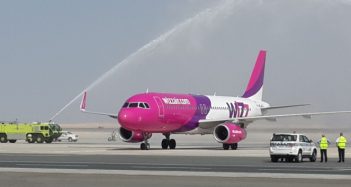Qatar Airways has announced it will introduce an additional 28 flights per week in and out of the United Arab Emirates (UAE) from next year as it resumes flights to Sharjah and launches flights to Al Maktoum International Airport at Dubai World Central, complementing its existing flights to Dubai International Airport.
“The ever increasing demand for flights to the UAE has provided the business case for expanding our services to Sharjah and Dubai World Central,” said Akbar Al Baker, chief executive officer, Qatar Airways. “The location of both airports will offer travellers alternative options to reach their final destination when flying to Dubai.”
Both new routes will commence from March 1, 2014 and will be operated twice daily using Airbus A320 equipment. The airline anticipates a significant amount of connecting traffic on the flights, affording customers from Europe, Africa and the America’s with an increased availability of flights to the UAE, while passengers from Australia, Asia and the Indian subcontinent will have convenient connection times when transiting via Doha.
The settlement of Sharjah dates back some 6,000 years when it is believed to have been called Sarcoa. The population was small and people relied on trade and sea faring in addition to, farming, hunting, fishing and pearling. Many of the early settlements were based around the ‘falaj’, a man made underground water course. Today Sharjah is the third largest of the seven states which form the United Arab Emirates and offers an impressive array of over twenty museums, several art galleries and beautifully restored heritage areas in this bustling port city.
The Emirate’s own national carrier, Air Arabia, dominates scheduled operations at Sharjah International Airport and has played a key role in its recent economic development thanks to its strong network of low-cost flights into international markets. Air Arabia introduced flights between Sharjah and Doha in June 2004 shortly after Qatar Airways ended its previous flights to the Emirate in April 2004. Initially operated on a five times weekly basis, Air Arabia has subsequently boosted capacity to daily (from May 2005), ten times weekly (from March 2009) and double daily (from May 2011). An estimated 75,000 bi-directional O&D passengers travelled on the route in 2012.
Operations commence at Al Maktoum International
Qatar Airways becomes the latest carrier to confirm plans to serve Al Maktoum International Airport at Dubai World Central (DWC). The airport, located in the Jebel Ali area of Dubai southwest of the city, was opened for passenger operations this week and is part of a strategic initiative of the Government of Dubai to establish an aerotropolis. European carrier Wizz Air is the first to use the facility and Jazeera Airways will introduce flights from Kuwait on October 31, 2013. Only last week we reported that Gulf Air has also confirmed their intent to offer flights from Bahrain.

The first commercial passenger flight, a Wizz Air service from the Hungarian capital Budapest, touched down at Dubai World Central on October 27, 2013, when a large delegation of local dignitaries and aviation officials toured the facility to mark its official opening.
“Al Maktoum International at Dubai World Central will play a vital role in the future development of Dubai as a centre for trade, commerce, transport and logistics and tourism. I am impressed by the efficiency and convenience of this new terminal,” said HH Sheikh Ahmed Bin Saeed Al Maktoum, President of Dubai Civil Aviation Authority and Chairman of Dubai Airports during the tour. “The opening of this facility signals the historic beginning of a long-term plan to build the largest airport in the world to accommodate the tremendous passenger growth and contribute to the continued economic and social development of Dubai.”
Traffic growth at Dubai International
The opening of passenger operations at Al Maktoum International comes as Dubai International Airport continues its rapid growth. The facility, the world’s second busiest airport for international passengers, rose 13.1 per cent in September, according to the latest traffic statistics issued today by operator Dubai Airports.
Passenger traffic in September totalled 5,407,326, an increase of 13.1 per cent compared to 4,780,394 during the corresponding month in 2012. Year to date traffic is up 16 per cent to 49,379,165 compared to 42,565,340 recorded during the first nine months of 2012.
All regions recorded positive growth in September with the exception of South America (-6.9 per cent). Among the strongest markets in terms of percentage passenger growth were Eastern Europe (+65.1 per cent), driven by flydubai expansion to multiple destinations in the region and Emirates’ new service to Warsaw. Passenger traffic to and from Australasia rose 38.6 per cent as a result of Emirates' expansion and Qantas’ new operation connecting Australia and London through Dubai. On a country level, Australia (+41.7 per cent), France (+23.7 per cent), Saudi Arabia (+22.4 per cent), Thailand (+21.8 per cent) and the UK (+21.7 per cent) saw the largest increases.
In terms of overall passenger numbers, Western Europe traffic took over as the top market thanks to robust growth (+14.8 per cent) during the month. AGCC came in second thanks to 15 per cent year-on-year passenger traffic growth. The Indian subcontinent, which took third spot, continued to show positive growth (+9.8 per cent) due to the expansion of several Indian carriers including Indigo, Spice Jet and Air India Express.
“Passenger and cargo traffic growth continue unabated and Dubai International is on track to eclipse our projections for 65.4 million passengers and 2.7 million tonnes of cargo,” said Paul Griffiths, CEO of Dubai Airports. “With the opening of our new passenger terminal at Al Maktoum International at Dubai World Central, and the ongoing expansion at Dubai International, Dubai’s aviation infrastructure continues to make it an attractive destination for tourism, trade and commerce.”





